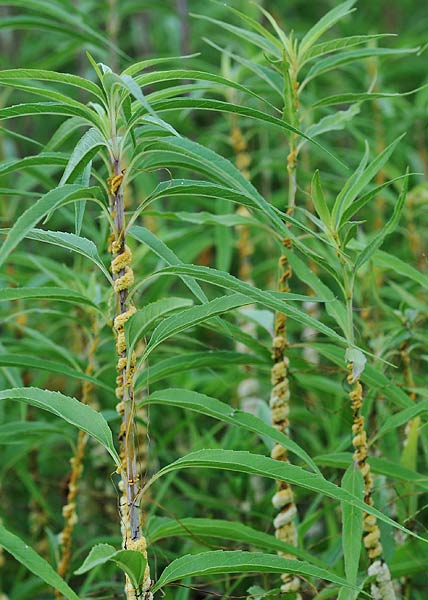
Date: July 6, 2012. Location: Williams Prairie (map)
| Classification Hierarchy | |
| Kingdom | Plantae |
| Subkingdom | Tracheophyta |
| Superdivision | Spermatophyta |
| Division | Magnoliophyta |
| Class | Magnoliopsida |
| Subclass | Asteridae |
| Order | Solanales |
| Family | Cuscutaceae (Convolvulaceae) |
| Genus | Cuscuta |
| Species | Cuscuta glomerata |

Date: July 6, 2012. Location: Williams Prairie (map)
USDA Plant Profile Flora of N. America
Scientific Name: Cuscuta glomerata
Common Name: Rope dodder
Origin: Native
Notes: C. dodder is a wetland vine that lives as a stem parasite on several species of plants. In our area it seems to have a special attraction to the sawtooth sunflower (Helianthus grosseserratus). C. glomerata seedlings appear in mid-May growing quickly and looking like a tangle of orange string by July. When it locates a suitable host it entwines the stem. A yellowish inflorescence of sessile flowers, in compact clusters (glomerules) grows in parallel rows on either side of the vine stem. Beneath these, periodically, a haustorium grows from the bottom of the vine stem to penetrate the tightly appressed stem of the host plant. A few weeks later the inflorescence turns white, the stem becomes grey and withers, and it is about this time that the white corollas, yellow anthers, and globular stigmas emerge from within the overlapping floral bracts. C. glomerata is generally considered non-photosynthetic; however, it does have some green structures. See the comments section below the photo grouping.
Additional references: 1, 2, 3, 4, 5, 6, 7, 8, 9, 10, 11, 12, 13, 14, 15, 16, 17, 18, 19.
Flowers: July, white, five corolla lobes—labeled petals in images, five anthers, two styles with their stigma, five sepals are the innermost of the bracts (which they very much resemble) surrounding the flower.
Leaves: Infrequent and reduced to "scale like" structures that occur at nodes along the vine stem.
Glossaries of botanical terms: 1, 2, 3, 4, 5, 6, 7, 8, 9, 10, 11, 12.
Comments: Cuscuta is a member of the Convolvulaceae family of plants. A principal characteristic of this family is a winding stem behavior. Cuscuta plants are stem parasites that wind around the stem of a host plant. Cuscuta flowers have an unusual structure called infrastaminal scales (IFS). These are important taxonomic clues for separating species. These are being studied (ref. 17) but as yet their function has not been confirmed.
The Cuscuta (dodder) genera with its wide distribution of 194 or more species has fascinated botanists for a couple of centuries; but, it is only recently that the investigative tools have been available to make sense of the taxon’s unusual features in terms of its taxonomy and its evolution.
Cuscuta species are categorized as holoparasites (Gr. holo=whole) or obligate parasites. Each term indicates that the plant is wholly dependent on a host plant for its sustenance. The host provides support, fixed carbon (a product of photosynthesis), and water and nutrients to the dodder plant. With these things provided, the dodder plant has little need for photosynthetic structures or root structures and through evolution these structures have become greatly reduced. It is worth noting that there is another kind of plant parasite called a hemiparasite (Gr. hemi or Lat. semi = half). These plants are usually green and can fix their own carbon photosynthetically but they rely on root associations with fungi or other plants to help provide water and nutrients.
Plants (such as dodder) which are not green are sometimes said to lack chlorophyll. This is an overstatement since plants that are not green and may not be photosynthetic can still have small amounts of chlorophyll located in select anatomical regions, especially those associated with seeds. Plants that are not photosynthetic most likely have lost this capability evolutionarily. While there are no longer chloroplasts capable of photosynthesis in these plants, electron micrographs have revealed plastid like structures that might still play some useful role (the storage of starch, for example). The utility of these plastids is a current topic of research.
Time lapse videos showing dodder shoot development can be interesting. Here are two. ( 1. 2. )